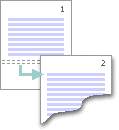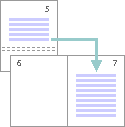Change the layout or formatting in one section of your document
You can use section breaks to change the layout or formatting of a page or pages in your document. For example, you can lay out part of a single-column page as two columns. You can separate the chapters in your document so that the page numbering for each chapter begins at 1. You can also create a different header or footer for a section of your document.
Note: In Microsoft Office Word 2007, you can choose many page layouts from the gallery of new page designs. For example, you can add a single-column page that has a two-column section by clicking that page layout option in the gallery of New Page designs.

1. Section formatted as a single column
2. Section formatted as two columns
In this article
Types of section breaks that you can insert
Section breaks are used to create layout or formatting changes in a portion of a document. You can change the following formats for individual sections:
-
Margins
-
Paper size or orientation
-
Paper source for a printer
-
Page borders
-
Vertical alignment of text on a page
-
Headers and footers
-
Columns
-
Page numbering
-
Line numbering
-
Footnotes and endnotes
Notes:
-
A section break controls the section formatting of the text that precedes it. When you delete a section break, you also delete the section formatting for the text before the break. That text becomes part of the following section, and it assumes the formatting of that section. For example, if you separate the chapters of a document by using section breaks and then you delete the section break at the beginning of Chapter 2, Chapter 1 and Chapter 2 are in the same section and assume the formatting that previously was used only by Chapter 2.
-
The section break that controls the formatting of the last part of your document is not shown as part of the document. To change the document formatting, click in the last paragraph of the document.
-
The following examples show the types of section breaks that you can insert. (In each illustration, the double dotted line represents a section break.)
The Next Page command inserts a section break and starts the new section on the next page. This type of section break is especially useful for starting new chapters in a document.

The Continuous command inserts a section break and starts the new section on the same page. A continuous section break is useful for creating a formatting change, such as a different number of columns, on a page.

The Even Page or Odd Page command inserts a section break and starts the new section on the next even-numbered or odd-numbered page. If you want document chapters always to begin on an odd page or on an even page, use the Odd page or Even page section break option.

Change the document layout or formatting
-
Click where you want to make a formatting change.
You might want to select a portion of the document around which to insert a pair of section breaks.
-
On the Page Layout tab, in the Page Setup group, click Breaks.

-
In the Section Breaks group, click the section break type that fits the type of formatting change that you want to make.
For example, if you're separating a document into chapters, you might want each chapter to start on an odd page. Click Odd Page in the Section Breaks group.
Remove changes of the document layout
A section break defines where a formatting change occurs in the document. When you delete a section break, you also delete the section formatting for the text before the break. That text becomes part of the following section, and it assumes the formatting of that section.
Make sure that you're in Draft view so that you can see the double dotted line section break.
-
Select the section break that you want to delete.
-
Press DELETE.
No comments:
Post a Comment